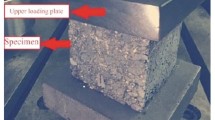Abstract
The aim of this study is to investigate the asphalt mixture anisotropy of both the modulus and Poisson’s ratio due to air voids using a discrete element modeling simulation method. Three three-dimensional cubic digital samples of asphalt mixture with different shapes of single air void were built using discrete element software PFC 3D. The aggregate gradation, air voids and mastic included in the digital samples were modeled using different contact models, with due consideration of the volumetric fractions of the different phases. Laboratory uniaxial complex modulus test and indirect tensile strength test were conducted to obtain material input parameters for numerical modeling. Simulation of the uniaxial cyclic compressive tests was performed on the three cubic samples loaded in three different directions. Dynamic modulus in three directions and Poisson’s ratio in six directions were calculated from the compression stress-strain responses. Results show that both the modulus and Poisson’s ratio are dependent on the preferential orientation of air voids. The anisotropy of the modulus and Poisson’s ratio increases as the pressure loading on the asphalt mixture increases. Compared to the modulus, Poisson’s ratio due to air voids has been shown to be more anisotropic. The maximum of Poisson’s ratio and modulus is shown to be up to 80% and 11% higher than the minimum, respectively.
Similar content being viewed by others
References
Adu-Osei A. Characterization of Unbound Granular Layers in Flexible Pavements[D]. Texas: Texas A&M University, 2000
Masad E, Tashman L, Somedavan N, et al. Micromechanics-Based Analysis of Stiffness Anisotropy in Asphalt Mixtures[J]. Journal of Materials in Civil Engineering, 2002, 14(5): 374–383
Underwood S, Heidari AH, Guddati M, et al. Experimental Investigation of Anisotropy in Asphalt Concrete[J]. Journal of the Transportation Research Board, 2005, 1929: 238–247
Zhang Y, Luo R, Lytton RL. Microstructure-Based Inherent Anisotropy of Asphalt Mixtures[J]. Journal of Materials in Civil Engineering, 2011, 23: 1473–1482
Mamlouk MS, Witczak MW, Kaloush KE, et al. Effect of Anisotropy on Compressive and Tensile Properties of Asphalt Mixtures[J]. Journal of Testing and Evaluation, 2002, 30(5): 432–438
Wang L, Hoyos LR, Wang J, et al. Anisotropic Properties of Asphalt Concrete: Characterization and Implications for Pavement Design and Analysis[J]. Journal of Materials in Civil Engineering, 2005, 17(5): 535–543
Zhang Y, Luo R, Lytton RL. Anisotropic Viscoelastic Properties of Undamaged Asphalt Mixtures[J]. Journal of Transportation Engineering, 2012, 138(1): 75–89
Kim S H, Little D, Masad E. Simple Methods to Estimate Inherent and Stress-Induced Anisotropy of Aggregate Base[J]. Journal of Transportation Research Board, 2005, 1913: 24–31
Liu T, Zhang X, Li Z, et al. Research on the Homogeneity of Asphalt Pavement Quality Using X-Ray Computed Tomography (CT) and Fractal Theory[J]. Construction and Building Materials, 2014, 68, 587–598
Kongkitkul W, Musika N, Tongnuapad C, et al. Anisotropy in Compressive Strength and Elastic Stiffness of Normal and Polymer-Modified Asphalts[J]. Soil and Foundations, 2014, 54(2): 94–108
Gudmarsson A, Ryden N, Birgisson B. Observed Deviations from Isotropic Linear Viscoelastic Behavior of Asphalt Concrete through Modal Testing[J]. Construction and Building Materials, 2014, 66, 63–71
Liang RY, Alfoul BA, Khasawneh M. Laboratory Investigation of Anisotropic Behaviour of HMA[C]. In: International Conference on Perpetual Pavement, Columbus, Ohio, 2006
Levenberg E, Uzan J. Triaxial Small-Strain Viscoelastic Viscoplastic Modeling of Asphalt Aggregate Mixes[J]. Mechanics of Time-Dependent Materials, 2004, 8(4): 365–384
Tashman L, Masad E, Little D, et al. A Microstructure-Based Viscoplastic Model for Asphalt Concrete[J]. International Journal of Plasticity, 2005, 21: 1659–1685
Chen J, Pan T, Huang X. Numerical Investigation into the Stiffness Anisotropy of Asphalt Concrete from a Microstructural Perspective[J]. Construction and Building Materials, 2011, 25(7): 3059–3065
Pan T, Tutumluer E, Carpenter SH. Effect of Coarse Aggregate Morphology on Permanent Deformation Behavior of Hot Mix Asphalt[J]. ASCE Journal of Transportation Engineering, 2006, 132(7): 580–589.
Chen J, Pan T, Huang X. Evaluation of Styrene-Butadiene Latex as a Vibration Damping Admixture for Concrete: A Micromechanical Analysis[J]. Journal of the Chinese Institute of Engineers, 2013, 36(8): 1008–1016
Masad E, Jandhyala VK, Dasgupta N, et al. Characterization of Air Void Distribution in Asphalt Mixes Using X-Ray Computed Tomography[J]. Journal of Materials in Civil Engineering, 2002, 14(2): 122–129
Liu Y, Dai Q L, You ZP. Viscoelastic Model for Discrete Element Simulation of Asphalt Mixtures[J]. Journal of Engineering Mechanics, 2009, 135(4): 324–333
You ZP, Adhikari S, Dai QL. Three-Dimensional Discrete Element Models for Asphalt Mixtures[J]. Journal of Engineering Mechanics, 2008, 134(12): 1053–1062
You ZP, Buttlar WG. Discrete Element Modeling to Predict the Modulus of Asphalt Concrete Mixtures[J]. ASCE Journal of Materials in Civil Engineering, 2004, 16(2): 140–146
Author information
Authors and Affiliations
Corresponding author
Additional information
Funded by the National Natural Science Foundation of China (No. 51208178) and the Fundamental Research Funds for the Central Universities (No. 2015B17014)
Rights and permissions
About this article
Cite this article
Chen, J., Zhang, Q., Wang, H. et al. Numerical investigation into the effect of air voids on the anisotropy of asphalt mixtures. J. Wuhan Univ. Technol.-Mat. Sci. Edit. 32, 473–481 (2017). https://doi.org/10.1007/s11595-017-1621-y
Received:
Accepted:
Published:
Issue Date:
DOI: https://doi.org/10.1007/s11595-017-1621-y




